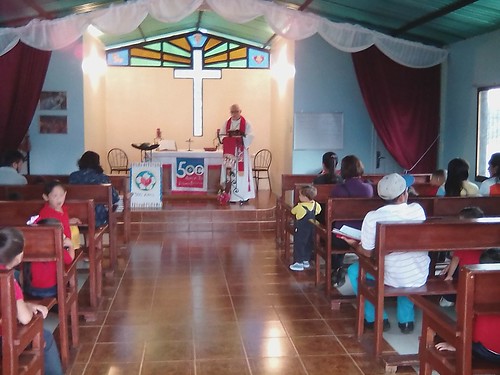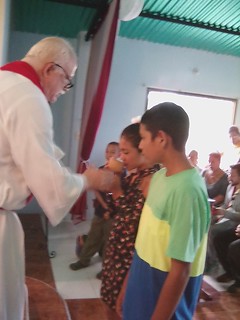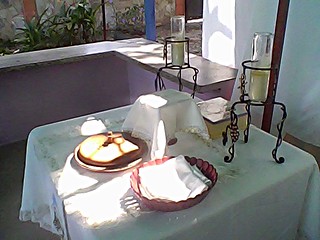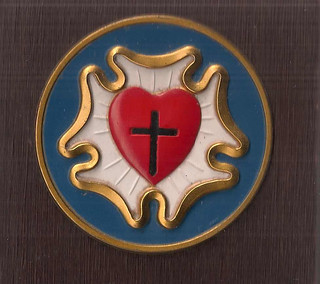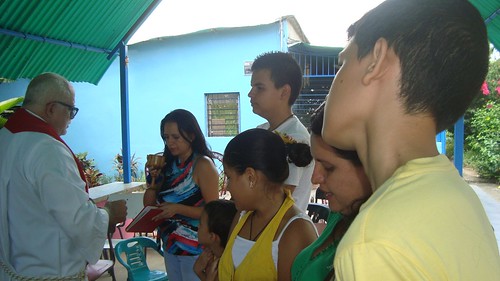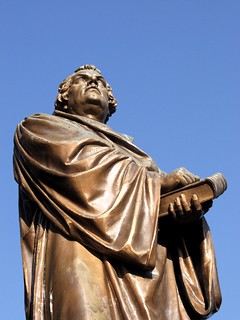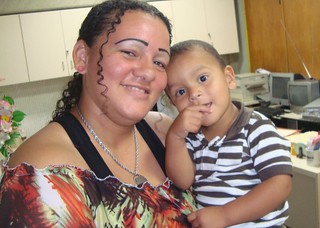To prepare for our celebration of Reformation Sunday on October 29, our youth made copies of Luther’s Rose out of construction paper and tissue while learning
the significance of the symbol. We also practiced singing “Castillo Fuerte” (“A Mighty Fortress”) and
“Dios es nuestro amparo” (“God is our refuge”). Both of these hymns are based on Psalm 46. “Castillo Fuerte”, number 546 in our new hymnal, is a Spanish translation of Martin Luther’s “Ein Feste Burg” by
Juan Bautista Cabrera (1837-1916), with the musical arrangement by Johann Sebastian Bach. The author of “Dios es nuestro amparo”, number 545 in Himnario Luterano, is unknown, but it is a favorite among Venezuelan Lutherans. Other Reformation Day hymns included
“Justificados, pues, por fe”, 802 in our hymnal. It’s another anonymous tune, but the lyrics are straight from Romans 5:1 in the Reina-Valera Bible (equivalent to the King James Bible in the Spanish-speaking world).
 |
Angi Santana.
|
Angi Santana, Luz Maria’s daughter, mounted the Luther roses on more solid cardboard for wall mounting. Then, on Sunday, each of the youth were presented with their plaque and encouraged to explain its significance to family members who were not in attendance.
During the week following Reformation Sunday, I shared with the preschool children the story of King Josiah's reformation in 2 Kings 22:1-23:30. The people of Judah had fallen into idolatry and error. The Temple of Jerusalem was in disrepair. The king and high priest were surprised when they found an original copy of the writings of Moses. He publicly read the book of the covenant to the people, beginning the restoration of true worship.
Next Sunday we will observe All Saints Day. Of course, October 31, 1517, is the exact date on which Martin Luther posted his 95 Theses on the doors of what is often called “the Castle Church” in Wittenberg, Germany, signalling the start of the Reformation of the 16th Century. In fact, the name of the church is All Saints Church. It was the chapel for Wittenberg University and the common practice was posting news and announcements on its wooden doors for the university community. Very likely no one gave Luther a second glance as he put up his document. Nowadays the doors are made of cast bronze with the 95 Theses engraved on them.
 |
Presentation of plaques.
|
We cannot know exactly what Luther was thinking at the time, but it was fortuituous for him to post the 95 theses on the doors of All Saints Church on the eve of All Saints Day. In his theses, a series of propositions offered for academic debate, Luther challenged the idea that the Pope could use a treasury of merit earned through devotion and good works by people declared to be “saints” by the Roman church to alleviate the time served by less exemplary people as penance in Purgatory with letters of
indulgence.
The early Christian church singled out for special honor those departed believers who had suffered imprisonment, torture, exile or death for their faith. Near the end of the second century, confessors (those who suffered for the faith, but were not put to death) were distinguished from martyrs (those who died for the faith). After the end of Roman persecutions, a confessor was a Christian noted for virtuous life. The building of churches above the graves of confessors and martyrs by the third century developed into the custom of placing their relics under or in altars and invoking their intercession. We still follow the custom of acknowledging heroes of the faith in the New Testament or early church history with the title of saint (e.g., St. Paul, St. Augustine). But, thanks to Luther and his fellow reformers, we now understand the entire church, both on earth and in heaven, to be the communion of the saints, who are all who have been declared righteous in God’s eyes through faith in Jesus Christ. According to the Lutheran Confessions, the saints in heaven may pray for the church on earth (Apology to the Augsburg Confession XXI 9), yet it does not follow that they are to be invoked. The saints in heaven are not mediators of intercession or redemption (Apology XXI 14–30). Invocation and prayers to saints are prohibited (Smalcald Articles-II II 25), but the confessions approve honoring the saints (Augsburg Confession XXI 4) in three ways: 1. By thanking God for examples of His mercy; 2. By using the saints as example for strengthening our faith; 3. By imitating their faith and other virtues.
 |
The reformation of King Josiah.
|
A special day to honor all was kept on May 13 in the churches of the eastern Roman Empire according to Ephraem Syrus (who died around 373 A.D.) This may be why Pope Boniface IV dedicated the Pantheon, a former pagan temple, in Rome and an architectural marvel with the world’s largest masonry dome, as a church in honor of the Virgin Mary and all martyrs on May 13, 609 (which it remains to this day). But early in the eighth century, Pope Gregory III dedicated a chapel in Rome on November 1 in honor of all departed saints. In 837 Pope Gregory IV ordered the observance of All Saints Day on November 1 throughout western Christendom. By the end of the 13th Century, November 2 was designated as All Souls Day to follow All Saints Day as the day to request requiem masses for those believed to be in purgatory.
In Venezuela, the second day of November often is called el Día de los Muertos (Day of the Dead), but unlike Mexico there is no skull candy, parades or altars in the graveyard with food offerings for the departed. For many people, the day has little religious significance, but rather is the customary time to visit, clean and place fresh flowers on the graves of loved ones. Halloween is considered a North American holiday. Although retail stores will put up Halloween displays and sell Halloween-related merchandise, many evangelical sects strongly oppose Halloween for its supposed pagan origins.

So what about those pagan origins? The Samhain harvest festival appears to be a purely Irish, not a pan-Celtic, tradition. It’s not even mentioned in any historical documents until the ninth century, long after St. Patrick evangelized Ireland in the fifth century. Whether either Pope Gregory III in 731 or Pope Gregory IV in 837 was worried about any survival of Irish paganism is not certain. Scottish and Irish immigrants did bring some of their folkways to the United States in the 19th Century, which became popularized as Halloween traditions. For example, their skill at carving out turnips or beets to place candles inside was applied to the pumpkin,
a very North American plant. (A similar type of giant squash, known as auyama, is found in Venezuela, but it is a
different species (Cucurbita moschata) than the
North American pumpkin (Cucurbita pepo).) “Trick or treating”, as we know it,
began in Canada in the 1920s. While a direct link between modern Halloween and ancient Celtic paganism is dubious at best, there is reason to think of Halloween as primarily a North American secular holiday.
What we must consider is not the origin of Halloween, but what it has become, which is, for many people, an excuse to dabble in the occult. Certainly in my own experience, Halloween was a lot more fun in a social environment where witchcraft was only make-believe. That’s not the environment in which we now live. So we prefer to emphasize the significance of All Saints Day in church history, especially in relation to the Reformation. On this All Saints Sunday, we will remember the members or relatives of our members who have passed to eternal life:
The church sings the faithFrom October 21 until December 2, Luz Maria and I will be participating in an online course in introducing the new Spanish hymnal led by Gustavo Arturo Maita, the pastor of Príncipe de Paz (Prince of Peace) Lutheran Church, Mayaguez, Puerto Rico. He was baptized and raised as a member of Cristo Rey (Christ the King) Lutheran Church in Maturín, Venezuela, and was, in fact, the first child in Venezuela to receive a Lutheran education scholarship from LeadaChild. The Olathe, Kansas-based mission agency has provided similar scholarships to our preschool children since 2006.
 |
Gustavo Arturo Maita.
|
Pastor Maita began formal theological studies with the Juan de Frías Theological Institute in Venezuela and continued at Concordia Seminary in Buenos Aires,Argentina. He served his vicarage in the Dominican Republic and graduated from Concordia Seminary in Argentina. In 2017, he received a divine call from the Lutheran Church of Venezuela to serve as an Lutheran Church – Missouri Synod alliance missionary in Puerto Rico. As a church-planting pastor, he has shared preaching and teaching responsibilities at multiple church plants. Additionally, Pastor Maita is the Disaster Response Coordinator for Puerto Rico and provides long-distance disaster response consulting and in-person workshops for church leaders and laity in countries across the Caribbean.He is married to LCMS missionary Ruth Maita, a teacher who also serves in Puerto Rico. The couple has been blessed with two children, Mikhaela and Isaiah.
Go Beyond with Team South AmericaOn November 8-9, 2023, we will participate with other Global Lutheran Outreach (GLO) missionaries in an online event to raise money for GLO to provide us with critical support services without increasing the current 10 percent missionary assessment. For just one day, your donation to GLO will be tripled thanks to our generous campaign sponsors! All contributions received through the Go Beyond! event will be directed to the GLO general fund, and not to a specific missionary. We will ask you to give directly to GLO so that it may continue its vital role as our sponsoring organization. Through GLO we receive international health insurance, plus accounting and tax services. GLO also underwrites the Medicine for Venezuela project, which supplies non-prescription medicines to members of Lutheran congregations throughout Venezuela; ministry to Venezuelan immigrants in Santiago, Chile; and enables the sending of missionaries by national Lutheran church-bodies around the world that lack a missionary support infrastructure.
 |
| Adrian Ventura in Wittenberg. |
Luz Maria and I will be part of Team South America, which also includes Pastor Adrian and Cruz Maria Ventura, Corali García Ramos, and Elianeth Pineda Vielma, all Venezuelan expatriates in Chile, and Maira Ferrari de Muller, a Lutheran teacher and GLO board member in Montevideo, Urugay. We have set a goal of raising $4,000 for GLO, which with matching funds will total $12,000. Team South America will have its own Web page to receive online donations. The Go Beyond event will last from 2:00 pm US Eastern time, November 8 until 2:00 pm ET November 9.
Here is where to find our Team South America Web site:
https://charidy.com/glo/samer
Adrian Ventura is the first Venezuelan national pastor that I met in 2002. For 20 years he was the pastor of Cristo Rey (Christ the King) Lutheran Church in Maturín, Venezuela, and twice served as president of the Lutheran Church of Venezuela. He is now the pastor of Divine Providence Lutheran Church in Santiago, Chile. We ask the God of all comfort to bring peace and comfort to his wife, Cruz Maria, upon the recent death of her father. May the promise of a blessed reunion in heaven be the balm that heals hearts which are separated by distance.

































